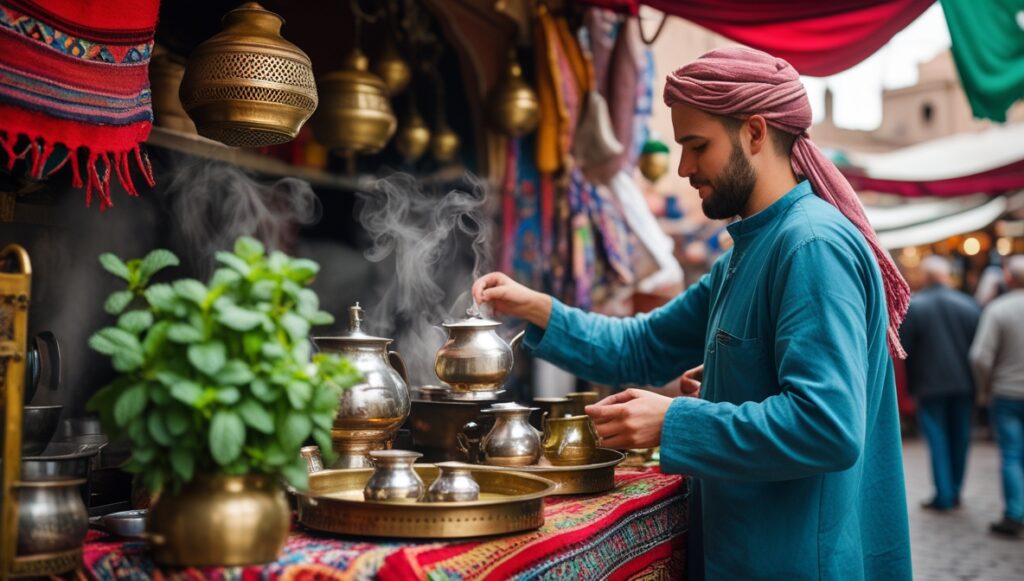Introduction
Moroccan Mint Tea, also known as “Atay Bi Nana,” is more than just a beverage—it is a cultural emblem of Morocco. This refreshing and aromatic tea is deeply ingrained in Moroccan hospitality and social life. Whether served in bustling souks, elegant riads, or during family gatherings, Moroccan Mint Tea is a symbol of warmth and friendship. Its distinctive sweet and minty flavor, coupled with the intricate preparation and pouring ritual, makes it a unique and cherished tradition.


History & Cultural Significance
Moroccan Mint Tea dates back to the 18th century when tea was introduced to Morocco through trade with Europe, particularly with Britain. The addition of fresh mint leaves and generous amounts of sugar transformed simple green tea into the beloved Moroccan Mint Tea. Traditionally, it is served three times, with each serving symbolizing a different aspect of life: bitter like life, sweet like love, and gentle like death. It plays a vital role in Moroccan hospitality, social gatherings, and even business negotiations.
Ingredients & Regional Variations
Key Ingredients:
Chinese Gunpowder Green Tea
Fresh Spearmint Leaves (Nana Mint)
Sugar (or Honey as a modern alternative)
Boiling Water
Regional Variations:
Northern Morocco: Stronger, more concentrated, and served in smaller glasses.
Saharan Region: Uses desert herbs for a unique, earthy taste.
Modern Twists: Some variations include orange blossom water, lemon, or cinnamon for added flavor.
Cooking Process & Difficulty Level

Difficulty Level: Beginner-friendly
Step-by-Step Guide:
Boil water in a teapot.
Rinse 1 tbsp of Gunpowder Green Tea with hot water and discard.
Add fresh mint leaves and sugar to the teapot.
Pour boiling water over the mixture and let it steep for 5 minutes.
Pour the tea from a height into small glasses to create a foamy top.
Serve hot and enjoy!
Where to Try Moroccan Mint Tea in Morocco
For the best Moroccan Mint Tea experience, visit:
Café Hafa (Tangier): Overlooking the Mediterranean, a historic spot since 1921.
Riad Yasmine (Marrakech): A beautiful riad serving authentic tea in a traditional setting.
Café des Épices (Marrakech): Located in the heart of the Medina, perfect for people-watching.
Café Clock (Fes): A modern twist on Moroccan traditions, great ambiance.
Pairing with Drinks & Side Dishes
Best Pairings:
With Sweets: Moroccan pastries like Chebakia, Maamoul, or Almond Briouats.
With Savory Dishes: Complementary with tagines, couscous, or grilled meats.
Fun Facts & Lesser-Known Trivia
Moroccan Mint Tea is often called “Berber Whiskey” due to its importance in daily life.
The higher the tea is poured, the better the aeration and taste.
Queen Victoria reportedly gifted Moroccan royalty with large tea shipments, helping popularize it.
Health Benefits & Nutrition
Rich in Antioxidants: Green tea provides numerous health benefits.
Aids Digestion: Mint soothes the stomach and promotes digestion.
Lowers Stress: The warm, sweet aroma helps with relaxation.
Diet-Friendly: Naturally low in calories when made without sugar.
How to Cook It at Home (Simple Recipe)
Ingredients:
1 tbsp Gunpowder Green Tea
10 fresh spearmint leaves
2 tbsp sugar (or honey)
2 cups boiling water
Method:
Add green tea to a teapot and rinse with boiling water.
Add mint leaves and sugar.
Pour boiling water over it and steep for 5 minutes.
Stir or pour from a height into a glass for aeration.
Serve and enjoy!
Global Influence & Fusion Cuisine
Moroccan Mint Tea has inspired modern iced tea variations worldwide.
Some fusion restaurants blend it with matcha, ginger, or fruit infusions.
It has been embraced in Middle Eastern and French cuisine.
Comparison with Similar Dishes
Moroccan Mint Tea vs. Turkish Tea: Moroccan tea is minty and sweet, while Turkish tea is stronger and unsweetened.
Moroccan Mint Tea vs. Chinese Green Tea: Moroccan Mint Tea is heavily flavored with sugar and mint, whereas traditional Chinese tea is consumed plain.
Moroccan Mint Tea vs. Thai Iced Tea: Thai tea is creamy with condensed milk, while Moroccan Mint Tea is light and refreshing.

